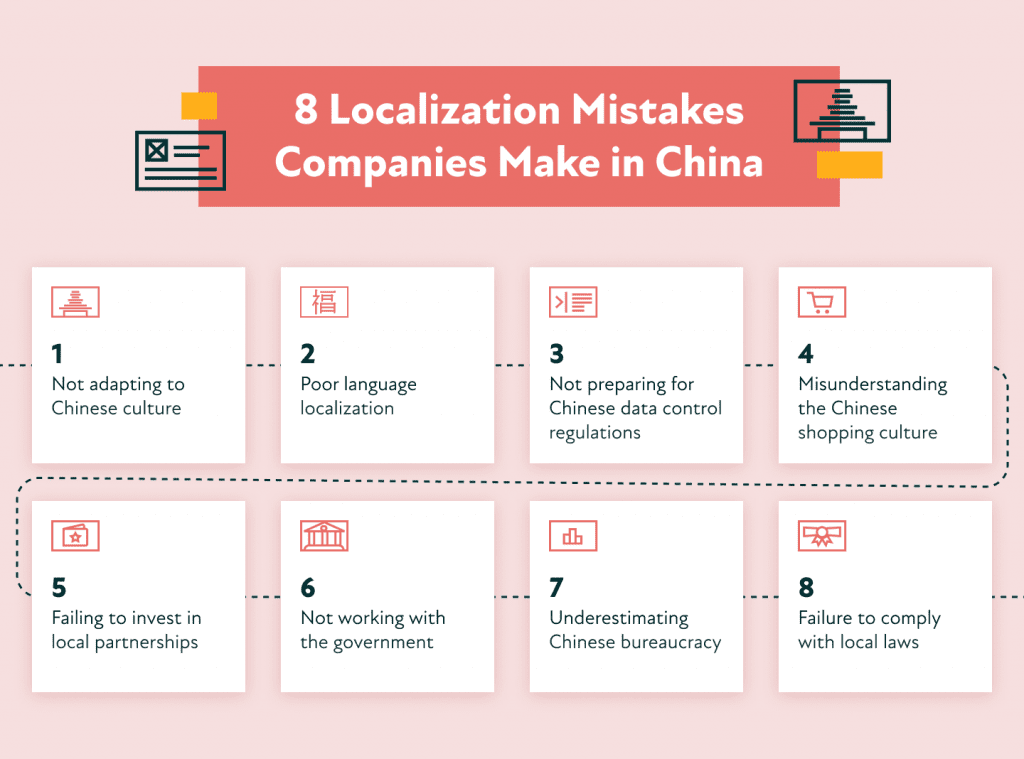
Eight Reasons Why Foreign Companies Fail in China
With the largest population in the world and booming spending power, it’s clear why China is a tempting market for any company. More than 20% of the global population resides in China. Remarkably, China is undergoing the most rapid growth of any country in its middle class, a phenomenon that aligns with the historic expansion of the middle class worldwide, largely influenced by countries like India. By 2027, it is projected that China will have an estimated 1.2 billion people in the middle class, constituting a significant one-quarter of the global total.
This huge middle class can afford to spend big on consumer goods and entertainment. Breaking into this market, however, comes with challenges that even the largest brands struggle to overcome. eBay and Google attempted to get a foothold in China, surviving for four years before admitting defeat, while Uber retreated to after just two years. But why is it so difficult to break into the Chinese market?
Chinese culture and language are unique, bureaucracy is complex, and the government’s grip on every aspect of life and business is tenacious. These factors create a market environment that’s totally unlike other global economies. It is possible, however, to succeed in China – and the key is localization. With the right localization services, you’ll be able to avoid the eight main mistakes that cause other companies to fail.

1. Not adapting to Chinese culture
China’s remarkable cultural diversity stems from its vast landscape, encompassing 14 major cities, 23 provinces, 56 distinct ethnic groups, and seven major dialects. This rich tapestry of cultural nuances creates a unique and intricate mosaic that is often overlooked by foreign companies seeking to establish their presence in the Chinese market.
It’s crucial for foreign markets to recognize that China’s cultural intricacies are not only profound but also highly localized. Many foreign enterprises have faltered by failing to grasp the depth of this diversity, assuming a one-size-fits-all approach would suffice. However, the reality is that understanding and adapting to Chinese culture are fundamental to market success.
Rather than attempting to impose Western practices or preferences on Chinese consumers, foreign companies should strive to comprehend the intricacies of their culture and habits. This deeper cultural understanding allows brands to tailor their offerings to align with Chinese preferences, a strategy that can lead to a more successful market entry.
For instance, notable companies like Best Buy and Home Depot encountered challenges when they underestimated China’s cultural uniqueness. Best Buy replicated its flagship store model in China without considering local factors such as traffic congestion and neighborhood loyalty, which made smaller, neighborhood-based shops more appealing to Chinese consumers. Home Depot, on the other hand, wrongly assumed that Chinese homeowners shared the same DIY enthusiasm as their American counterparts. In reality, the Chinese middle class often prefers to hire professionals for home repairs and renovations. Home Depot’s failure to adapt its product offerings for the Chinese market also proved to be a significant setback.
In contrast, IKEA provides a compelling example of successful localization in China. By adapting its model to suit local tastes and demonstrating how Scandinavian design can harmonize with the Chinese home, IKEA has continued to expand its presence in the Chinese market.
2. Poor language and design localization
Language is vital for successful localization, but a word-for-word translation of your content rarely works. Direct translations don’t consider nuances, cultural differences, and China’s wide range of regional dialects. Working with experienced, professional, and native Chinese translators will help ensure that your content will connect to Chinese consumers genuinely.
Developing products that feature Chinese culture by design can be very lucrative, but brands should proceed with caution. Make sure you work with experts that understand China’s language and culture. Nike, for example, developed a range of sneakers for the Year of the Monkey. Nike included a Chinese character for “wealth” on one shoe and a character for “good fortune” on the other. What Nike failed to note is that when put together, the characters mean “becoming fat”! A lack of understanding for the Chinese language and culture resulted in a poor design choice that would not sell in the Chinese market.
3. Chinese data control regulations
China has some of the toughest data laws in the world with the government using data as a tool for political power and surveillance. This tight control impedes the free flow of data across borders and makes it difficult to market digital products and internet-enabled services, such as ride-hailing apps. Uber failed in China because it had to rely on local servers, while new regulations meant it would have needed both provincial and national approval for its activities. Uber found this loss of control over its data unworkable. If you want to succeed in the Chinese market, you must accept that China does not have free and open internet and prepare for a certain loss of control over your company’s website and data.
4. The Chinese shopping culture
Online shopping has become an integral part of Chinese consumer culture, undergoing a significant transformation over the years. Historically, Chinese consumers leaned towards nationally produced products over imports. However, there has been a noticeable shift in recent times, with an increasing desire for niche brands and specialty stores with items that offer something unique and stand out from the crowd. Today’s Chinese consumers are highly brand-savvy, digitally native, and increasingly focused on personalization, sustainability, and brand storytelling. They expect brands to offer not just products but experiences that reflect modern Chinese values, often blending both Eastern and Western influences.
One of the defining characteristics of the Chinese shopping culture is the strong affinity for online shopping. With the widespread use of smartphones, many Chinese consumers prefer to make their purchases through mobile apps. This preference aligns with the rise of platforms like Taobao, which have harnessed the mobile trend to build their success. Taobao, a prominent online shopping platform, is not only the eighth most visited website globally but is also designed to be mobile-responsive. It offers a user-friendly experience with navigation and call-to-action buttons that are large enough to be easily accessed without zooming in.
What sets Chinese online shopping apart is the emphasis on direct communication and building relationships between buyers and sellers. Taobao, for instance, facilitates this through instant messaging, allowing buyers to engage in direct conversations with sellers. This feature fosters what is known as “swift guanxi,” a concept deeply valued in Chinese culture, which represents the development of close relationships. In the context of shopping, this means that trust and relationship-building play a crucial role in the buying and selling process.
In addition to eCommerce platforms, success in China hinges on engaging with the right digital channels. Brands that localize effectively create tailored content for platforms like WeChat, Douyin, RED (Xiaohongshu), and Zhihu—each with its own content format, tone, and target audience. Social commerce is deeply integrated into the consumer journey, so brands must think beyond translation and align with each platform’s expectations, including influencer collaborations, interactive campaigns, and mobile-first design.
Incorporating these aspects of Chinese shopping culture into your localization strategy is essential for success in the Chinese market. Recognizing the preference for online shopping, mobile accessibility, and the significance of relationship-building and trust can significantly enhance a brand’s appeal and acceptance among Chinese consumers.
5. Failing to invest in local partnerships
Finding a Chinese partner makes entering this tricky market easier. Sometimes, it’s impossible without one. Use the knowledge and experience of your localization team to find a partner that works with you rather than focusing on their own competing services. Then, once you’ve found a supportive local partner, use its resources to your fullest advantage.
Groupon chose to partner with Tencent in China, making a big mistake on two fronts. Tencent already owned sites comparable to Groupon, so they didn’t have a big stake in Groupon’s success. At the same time, Groupon didn’t take full advantage of Tencent’s local knowledge, staff, and user base. It insisted on working, unsuccessfully, with its American model.
6. Not working with the government
Westerners often find it hard to understand just how pervasive the Chinese government is. Strict adherence to law and policy is essential. Directly challenging the government or bending the rules can result in your company and products being banned in China. Although the story is lengthy and complicated, Google is a prime example of this. It was unable to get along with the Chinese government and now its services are blocked or rendered near-useless in mainland China.
7. Underestimating Chinese bureaucracy
Many companies cite bureaucracy as one of the major issues when expanding into China. Obtaining necessary licenses and permits can be time-consuming and laborious. Day-to-day administration, product approvals, and labor laws may leave managers with piles of paperwork (often actual paperwork rather than digital paperwork!). Using a localization service that understands Chinese bureaucracy can alleviate stress from the process and ensure a smooth transition.
8. Failure to tackle compliance
Part of the bureaucratic burden of trading in China is compliance. Strict rules govern how products are designed, manufactured, sold, used, and even disposed of. When localizing your marketing campaign, make sure you’re fully up to speed with advertising laws that came into effect in 2015. Health foods cannot claim medical benefits, children under 10 are not allowed to endorse products, and alcohol cannot be drunk in an advert. Superlative words such as “best,” “world-class,” and “most” have also been banned. Compliance in gaming can extend to ratings, dialogue, and images.
In recent years, China has introduced more stringent cybersecurity, data protection, and advertising regulations. The Personal Information Protection Law (PIPL), which came into effect in 2021, places strict rules on how companies collect, store, and transfer user data. Brands must also comply with platform-specific rules, such as content moderation guidelines on Douyin or publishing restrictions on WeChat Official Accounts. These regulatory changes require not only legal review but also continuous content monitoring and agile localization workflows.
Companies That Failed In China
Entering the Chinese market is a formidable challenge, even for some of the most prominent brands in the Western and Asian worlds. The complexity of China’s diverse culture, consumer preferences, and rapidly evolving market dynamics has proven to be a formidable obstacle. Even industry giants have stumbled in their endeavors to establish a strong presence in China. In this section, we explore some notable examples of companies that faced substantial hurdles and ultimately failed to secure a lasting foothold in the Chinese market.
Walmart
Walmart, a global retail behemoth, encountered significant challenges in China, primarily due to its inability to adapt to local culture. Despite its success in various international markets and other countries, Walmart struggled to resonate with Chinese consumers. The failure stemmed from a lack of understanding of the intricacies of Chinese shopping behavior and preferences. The company’s efforts to replicate its Western business model without considering local factors led to subpar performance in the highly competitive Chinese retail landscape.
Best Buy
Best Buy, a well-known American electronics retailer, faced a multitude of challenges when attempting to expand in China. Its misalignment with the Chinese market was primarily due to ineffective strategies and a failure to adapt its business model. Furthermore, the Chinese name for Best Buy, “Baisimai,” which translates to “to buy after thinking 100 times,” presented a marketing hurdle. This name implied a cautious and hesitant approach to purchasing, which didn’t align with Best Buy’s business model. These factors contributed to the company’s struggles and eventual withdrawal from the Chinese market.
Airbnb
The renowned home-sharing platform Airbnb also grappled with difficulties in the Chinese market. A misunderstanding of Chinese culture and consumer behavior was at the heart of its challenges. Chinese consumers were more hesitant to trust strangers or rely on online reviews when it came to accommodation, which clashed with Airbnb’s business model. This mistrust, coupled with a competitive local market, posed substantial barriers to Airbnb’s success in China.
Amazon
Amazon, a global e-commerce giant, faced formidable challenges when trying to establish a foothold in the Chinese market. Local competitors had a more profound understanding of Chinese consumers’ preferences, shopping habits, and cultural nuances. The integration of social media and e-commerce in China was more prevalent, which was not Amazon’s strong suit. These factors, coupled with intense local competition, ultimately led Amazon to exit the Chinese market.
Burberry
Burberry, a luxury fashion brand, also struggled in China, primarily due to a lack of understanding of the local market and cultural misunderstandings. The company’s marketing campaigns in China misrepresented Chinese culture, leading to public backlash. This misstep underscored the importance of cultural sensitivity and market research for foreign brands attempting to penetrate the Chinese market.
These examples serve as cautionary tales, emphasizing the vital role of cultural adaptation, consumer understanding, and strategic alignment when attempting to thrive in the dynamic and complex Chinese market. Successful market entry in China requires more than just global recognition and market share; it demands a deep appreciation for the intricacies of the local landscape.
Is doing business in China getting harder?
Doing business in China has always been a challenging endeavor, but recent developments indicate that it might be getting even more complicated. Many global companies have made brand mistakes when entering China, underestimating the importance of cultural nuances and localization. Understanding the unique working culture in China is paramount, as relationships, trust-building, and respect for hierarchy play pivotal roles in business interactions.
Furthermore, a rapidly changing regulatory environment and increased competition from local companies pose additional obstacles for companies entering China. Navigating this intricate landscape necessitates a profound commitment to understanding the local market, adapting strategies, and demonstrating cultural sensitivity.
If you’re determined to succeed in China, we can help with our deep understanding of China’s culture and language, and how the marketplace works. Contact us now to start working with our native Chinese translators, voice actors, and localizers. With support from our Shanghai office, we guarantee the highest-quality localization.
Need fast, high-quality translation?
Translate nowWhat our customers are saying









